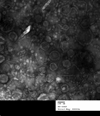Pluronic P85 enhances the efficacy of outer membrane vesicles as a subunit vaccine against Brucella melitensis challenge in mice
- PMID: 23163875
- PMCID: PMC4426994
- DOI: 10.1111/1574-695X.12010
Pluronic P85 enhances the efficacy of outer membrane vesicles as a subunit vaccine against Brucella melitensis challenge in mice
Abstract
Brucellosis is the most common zoonotic disease worldwide, and there is no vaccine for human use. Brucella melitensis Rev1, a live attenuated strain, is the commercial vaccine for small ruminants to prevent B. melitensis infections but has been associated with abortions in animals. Moreover, strain Rev1 is known to cause disease in humans and cannot be used for human vaccination. Outer membrane vesicles (OMVs) obtained from B. melitensis have been shown to provide protection similar to strain Rev1 in mice against B. melitensis challenge. In the present work, we tested the efficacy of Pluronic P85 as an adjuvant to enhance the efficacy of Brucella OMVs as a vaccine. P85 enhanced the in vitro secretion of TNF-α by macrophages induced with OMVs and P85. Further, P85 enhanced the protection provided by OMVs against B. melitensis challenge. This enhanced protection was associated with higher total IgG antibody production but not increased IFN-γ or IL-4 cytokine levels. Moreover, P85 alone provided significantly better clearance of B. melitensis compared to saline-vaccinated mice. Further studies are warranted to find the mechanism of action of P85 that provides nonspecific protection and enhances the efficacy of OMVs as a vaccine against B. melitensis.
© 2012 Federation of European Microbiological Societies. Published by Blackwell Publishing Ltd. All rights reserved.
Figures






Similar articles
-
A history of the development of Brucella vaccines.Biomed Res Int. 2013;2013:743509. doi: 10.1155/2013/743509. Epub 2013 Jun 3. Biomed Res Int. 2013. PMID: 23862154 Free PMC article. Review.
-
A Brucella melitensis M5-90 wboA deletion strain is attenuated and enhances vaccine efficacy.Mol Immunol. 2015 Aug;66(2):276-83. doi: 10.1016/j.molimm.2015.04.004. Epub 2015 Apr 17. Mol Immunol. 2015. PMID: 25899866
-
Characterization of outer membrane vesicles from Brucella melitensis and protection induced in mice.Clin Dev Immunol. 2012;2012:352493. doi: 10.1155/2012/352493. Epub 2011 Dec 29. Clin Dev Immunol. 2012. PMID: 22242036 Free PMC article.
-
Immunization of mice with a novel recombinant molecular chaperon confers protection against Brucella melitensis infection.Vaccine. 2014 Nov 20;32(49):6659-66. doi: 10.1016/j.vaccine.2014.09.013. Epub 2014 Sep 19. Vaccine. 2014. PMID: 25240754
-
The development of a human Brucella mucosal vaccine: What should be considered?Life Sci. 2024 Oct 15;355:122986. doi: 10.1016/j.lfs.2024.122986. Epub 2024 Aug 14. Life Sci. 2024. PMID: 39151885 Review.
Cited by
-
A history of the development of Brucella vaccines.Biomed Res Int. 2013;2013:743509. doi: 10.1155/2013/743509. Epub 2013 Jun 3. Biomed Res Int. 2013. PMID: 23862154 Free PMC article. Review.
-
Meta-Analysis and Advancement of Brucellosis Vaccinology.PLoS One. 2016 Nov 15;11(11):e0166582. doi: 10.1371/journal.pone.0166582. eCollection 2016. PLoS One. 2016. PMID: 27846274 Free PMC article.
-
Development of new generation of vaccines for Brucella abortus.Heliyon. 2018 Dec 26;4(12):e01079. doi: 10.1016/j.heliyon.2018.e01079. eCollection 2018 Dec. Heliyon. 2018. PMID: 30603712 Free PMC article. Review.
-
Outer Membrane Vesicles From Brucella melitensis Modulate Immune Response and Induce Cytoskeleton Rearrangement in Peripheral Blood Mononuclear Cells.Front Microbiol. 2020 Oct 19;11:556795. doi: 10.3389/fmicb.2020.556795. eCollection 2020. Front Microbiol. 2020. PMID: 33193138 Free PMC article.
-
Evaluation of immune responses to Brucella vaccines in mouse models: A systematic review.Front Vet Sci. 2022 Sep 2;9:903890. doi: 10.3389/fvets.2022.903890. eCollection 2022. Front Vet Sci. 2022. PMID: 36118342 Free PMC article.
References
-
- Adone R, Francia M, Pistoia C, Petrucci P, Pesciaroli M, Pasquali P. Protective role of antibodies induced by Brucella melitensis B115 against B. melitensis and Brucella abortus infections in mice. Vaccine. 2012 - PubMed
-
- Allison AC, Byars NE. An adjuvant formulation that selectively elicits the formation of antibodies of protective isotypes and of cell-mediated immunity. J Immunol Methods. 1986;95:157–168. - PubMed
-
- Asaad AM, Alqahtani JM. Serological and molecular diagnosis of human brucellosis in Najran, Southwestern Saudi Arabia. J Infect Public Health. 2012;5:189–194. - PubMed
-
- Baldwin CL, Goenka R. Host immune responses to the intracellular bacteria Brucella: does the bacteria instruct the host to facilitate chronic infection? Crit Rev Immunol. 2006;26:407–442. - PubMed
Publication types
MeSH terms
Substances
Grants and funding
LinkOut - more resources
Full Text Sources
Other Literature Sources
